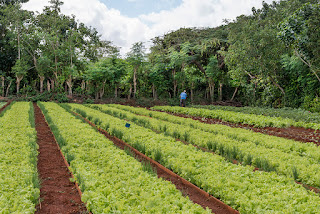Cuba Today
by Ferida Wolff
My backyard really expanded last week — all the way to Cuba!
We had the opportunity to visit the island that is so close to us, a mere ninety miles from Miami, and yet so far from our ability to interact, at least until recently. We went with Grand Circle Foundation, one of the licensed groups that lead people-to-people cultural exchange tours. What we found was a resourceful culture, friendly people, and music that enlivens everything.
Much of what you see is reflective of the 1950s (oh, those cars!) when Cuba was a booming tourist destination. But all was not well in the coastal paradise. There was a large class discrepancy. In 1959, Fidel Castro ousted Fulgencio Batista who, when it looked like he would be voted out of power, had taken over total control of the government. Most privately owned businesses and properties became state-owned. Cuba became aligned with the Soviet Union and communism and estranged from the United States. This relationship lasted until the USSR was officially dissolved in 1991. The dissolution left Cuba in crisis. Without the economic support the USSR had provided, food was scarce and poverty reigned.

Cuba is still struggling. There are remnants of functional Soviet architecture but also of the grander architectural styles that came with Spanish colonization. Much of that, unfortunately, is in need of repair, which is too costly for most Cubans. Buildings occasionally fall down, sometimes with the people in them. Many of the buildings have black mold on them, something that is hard to control in such a humid climate.
Cuba’s new leader Raul Castro, Fidel’s brother, is beginning to loosen some restrictions. We visited a cooperative organic farm. The land is still state-owned but the produce can be sold privately. We ate in a few paladars, small, privately owned restaurants located in homes. They provide a chance to practice both Spanish and English, depending on which side of the menu you’re on. Our tour was a busy one, but it left us time to wander the cities and interact with local residents who are eager to connect.
And yes, we did see nature in various forms. We saw cranes looking for lunch in Cienfuegos, a city that is a UNESCO World Heritage Site. We visited a family that owns a tobacco farm where there was a variety of livestock, lots of chickens and a rooster who was intent on getting us to feed him some of the bananas we were eating (there were three delicious local varieties). We went through a nature preserve and learned about trees that are native, and some invasive, to Cuba. There was el Malacón, the miles-long promenade in Havana, a great place to see the harbor and a popular venue to stroll along.
Pages: 1 · 2
More Articles
- Jo Freeman Writes: Kennedy vs. Trump at the Libertarian National Convention
- Women's Health and Aging Studies Available Online; Inform Yourself and Others Concerned About Your Health
- Selective Exposure and Partisan Echo Chambers in Television News Consumption: Innovative Use of Data Yields Unprecedented Insights
- The Beige Book Summary of Commentary on Current Economic Conditions By Federal Reserve District Wednesday November 30, 2022
- Jo Freeman Reviews Thank You For Your Servitude: Donald Trump's Washington and the Price of Submission
- A la Frank Sinatra: "Come Fly With Me", U.S. Department of Transportation Airline Customer Service Dashboard
- "Henry Ford Innovation Nation", a Favorite Television Show
- Ferida Wolff's Backyard: Fireworks Galore!
- How They Did It: Tampa Bay Times Reporters Expose High Airborne Lead Levels at Florida Recycling Factory
- Veterans Health Care: Efforts to Hire Licensed Professional Mental Health Counselors and Marriage and Family Therapists






